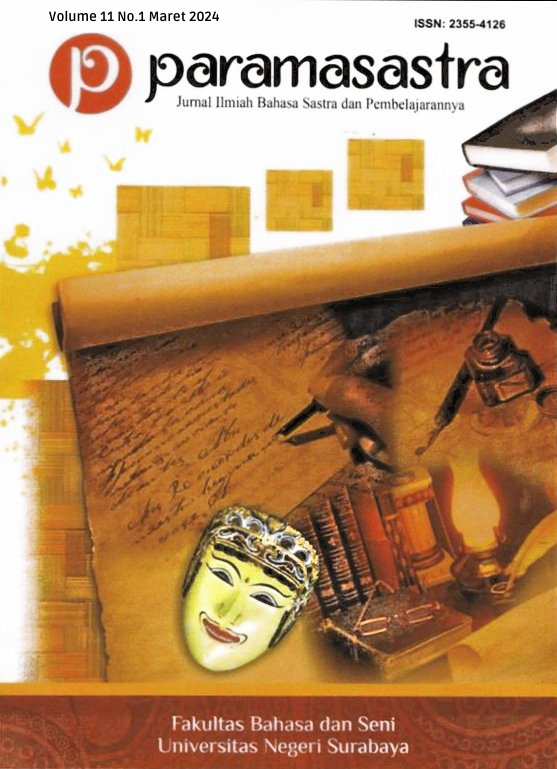An Analysis of Literary and Cultural Content in the TISOL Textbook ‘Sahabatku Indonesia’
DOI:
https://doi.org/10.26740/paramasastra.v11n1.p137-156Abstract
ABSTRACT
In TISOL teaching, one of the critical factors in supporting the learning process is the use of learning media such as teaching materials or textbooks. Hence, this research aims to determine whether literary and cultural content elements have been included in the BIPA textbook "Sahabatku Indonesia", especially at levels C1-C2. To obtain the results of this research, a qualitative approach was used with a content analysis method based on the scale developed by Nurgiyantoro. Therefore, the results of this research, in the BIPA book entitled 'My Indonesian Friend', volume I, is only 65% , and for volume II, the percentage is 72% if included in the Nurgiyantoro scale percentage classification, this is included in the "Quite Suitable" category. The book's content is considered appropriate to students' needs in terms of consistency, depth, and breadth of material, as well as accuracy and cultural and literary content displayed. So, these two books can be used by teachers in teaching BIPA through sufficient cultural and literary approaches. As for the development of these two books, the researcher suggests that the relationship between cultural and literary content be readjusted according to the theme of each unit or chapter.
Key Words: BIPA, Cultural Content, Literature, Foreign Students
References
Brannen, J. (2005). Mixing methods: The entry of qualitative and quantitative approaches into the research process. International journal of social research methodology, 8(3), 173-184.
Danandjaja, James. 1997. Folklor Indonesia: Ilmu Gosip, Dongeng, dan lain lain. Jakarta: PT Pustaka Utama Grafiti
Fahik, T. (2020). English Textbook: A Culture-Based Analysis.
Handayani, L., & Isnaniah, S. (2020). Analisis Kelayakan Isi Buku Ajar Sahabatku Indonesia Dalam Pembelajaran Bipa (Vol. 8, Issue 1).
Krippendorff, K. (2018). Content analysis: An introduction to its methodology. Sage publications.
Marlini, S. (2020). Zoom for BIPA Online Learning during COVID-19 Pandemic (Vol. 1, Issue 1).
Miles, M. B., & Huberman, A. M. (1994). Qualitative data analysis: An expanded sourcebook. sage.
Muslich, M. (2010). Text book writing: Dasar-dasar pemahaman, penulisan, dan pemakaian buku teks. Jogjakarta: Ar-Ruzz Media, 52, 47-52.
Naufalia, A., & Fajrideani, W. (2022.). Prosiding Struktur dan Makna Istilah Teknis pada Buku Cerita Rakyat dari Cirebon sebagai Bahan Penguatan Literasi Untuk BIPA 4.
Nurhuda, T. A., & Waluyo, H. J. (2017.). Pemanfaatan Sastra Sebagai Bahan Ajar Pengajaran Bipa.
Syafryadin, (2021). Bahasa Indonesia Bagi Penutur Asing( BIPA):Handbook.
Tomkins, GE, & Hoskisson, K. 1995. Language arts: Content and teaching strategies. Ohio:Merrill, an Imprant of Prentice Hall.
Tomlinson, B. 2012. "Materials development for language learning and teaching", Language Teaching, Vol. 45, no. 2
Yusril Hermansya, M. (2022). Presentation of Indonesian Cultural Elements In Bipa Teaching Materials Published By The Ministry Of Education And Culture. Bahasa Dan Sastra Indonesia), 4.
Downloads
Published
How to Cite
Issue
Section
 Abstract views: 244
,
Abstract views: 244
, PDF Downloads: 199
PDF Downloads: 199












